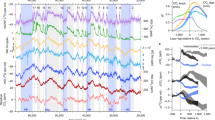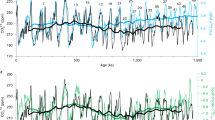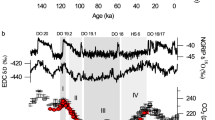Abstract
The most conspicuous feature of the record of past climate contained in polar ice is the rapid warming which occurs after long intervals of gradual cooling. During the last four transitions from glacial to interglacial conditions, over which such abrupt warmings occur, ice records indicate that the CO2 concentration of the atmosphere increased by roughly 80 to 100 parts per million by volume (1–4). But the causes of the atmospheric CO2 concentration increases are unclear. Here we present the stable-carbon-isotope composition (δ13CO2) of CO2 extracted from air trapped in ice at Taylor Dome, Antarctica, from the Last Glacial Maximum to the onset of Holocene times. The global carbon cycle is shown to have operated in two distinct primary modes on the timescale of thousands of years, one when climate was changing relatively slowly and another when warming was rapid, each with a characteristic average stable-carbon-isotope composition of the net CO2 exchanged by the atmosphere with the land and oceans. δ13CO2 increased between 16.5 and 9 thousand years ago by slightly more than would be estimated to be caused by the physical effects of a 5 °C rise in global average sea surface temperature driving a CO2 efflux from the ocean, but our data do not allow specific causes to be constrained.
This is a preview of subscription content, access via your institution
Access options
Subscribe to this journal
Receive 51 print issues and online access
$199.00 per year
only $3.90 per issue
Buy this article
- Purchase on Springer Link
- Instant access to full article PDF
Prices may be subject to local taxes which are calculated during checkout


Similar content being viewed by others
References
Barnola, J. M., Raynaud, D., Korotkevich, Y. S. & Lorius, C. Vostok ice core provides 160,000-year record of atmospheric CO2. Nature 329, 408–414 (1987).
Neftel, A., Oeschger, H., Staffelbach, T. & Stauffer, B. CO2record in the Byrd ice core 50,000–5,000 years BP. Nature 331, 609–611 (1988).
Fischer, H., Wahlen, M., Smith, H. J., Mastroianni, D. & Deck, B. Ice core records of atmospheric CO2around the last three glacial terminations. Science 283, 1712–1714 (1999).
Petit, J. R. et al. Climate and atmospheric history of the past 420,000 years from the Vostok ice core, Antarctica. Nature 399, 429–436 (1999).
Marino, B., McElroy, M. B., Salawitch, R. J. & Spaulding, W. G. Glacial-to-interglacial variations in the carbon isotopic composition of atmospheric CO2. Nature 357, 461–466 (1992).
Anklin, M., Barnola, J.-M., Schwander, J., Stauffer, B. & Raynaud, D. Processes affecting the CO2concentrations measured in Greenland ice. Tellus B 47, 461–470 (1995).
Delmas, R. J. Anatural artefact in Greenland ice core CO2measurements. Tellus B 45, 391–396 (1993).
Barnola, J. M. et al. CO2evolution during the last millennium as recorded by Antarctic and Greenland ice. Tellus B 47, 264–272 (1995).
Indermühle, A. et al. Holocene carbon-cycle dynamics based on CO2trapped in ice at Taylor Dome, Antarctica. Nature 398, 121–126 (1999).
Fairbanks, R. G. The age and origin of the “Younger Dryas Climate Event” in Greenland ice cores. Paleoceanography 5, 937–948 (1990).
Leuenberger, M., Siegenthaler, U. & Langway, C. C. Carbon isotope composition of atmospheric CO2during the last ice age from an Antarctic ice core. Nature 357, 488–490 (1992).
Tans, P. P., Berry, J. A. & Keeling, R. F. Oceanic 13C/12C observations: a new window on ocean CO2uptake. Glob. Biogeochem. Cycles 7, 353–368 (1993).
Friedli, H., Lotscher, H., Oeschger, H., Siegenthaler, U. & Stauffer, B. Ice core record of the 13C/12C of atmospheric CO2in the past two centuries. Nature 324, 237–238 (1986).
Broecker, W. S. & Henderson, G. M. The sequence of events surrounding Termination II and their implications for the cause of glacial-interglacial CO2changes. Paleoceanography 13, 352–364 (1998).
Takahashi, T., Olafsson, J., Goddard, J. G., Chipman, D. W. & Sutherland, S. C. Seasonal variation of CO2and nutrients in the high-latitude surface oceans: a comparative study. Glob. Biogeochem. Cycles 7, 843–878 (1993).
Mook, W. G., Bommerson, J. C. & Staverman, W. H. Carbon isotope fractionation between dissolved bicarbonate and gaseous carbon dioxide. Earth Planet. Sci. Lett. 22, 169–176 (1974).
Weiss, R. F. Carbon dioxide in water and seawater: the solubility of a non-ideal gas. Mar. Chem. 2, 203–215 (1974).
Guilderson, T. P., Fairbanks, R. G. & Rubenstone, J. L. Tropical temperature variations since 20,000 years ago: modulating interhemispheric climate change. Science 263, 663–665 (1994).
CLIMAP Project Members Seasonal Reconstructions of the Earth's Surface at the Last Glacial Maximum ( Map and Chart Ser., MC-3, Geol. Soc. Am., Boulde, (1981).
Fairbanks, R. G. A17,000-year glacio-eustatic sea level record—influence of glacial melting rates on the Younger Dryas Event and deep-ocean circulation. Nature 342, 637–642 (1989).
Duplessy, J. C. et al. Deepwater source variations during the last climatic cycle and their impact on the global deepwater circulation. Paleoceanography 3, 343–360 (1988).
Wahlen, M., Allen, D. & Deck, B. Initial measurements of CO2concentrations (1530 to 1940 AD) in air occluded in the GISP 2 ice core from central Greenland. Geophys. Res. Lett. 18, 1457–1460 (1991).
Smith, H. J., Wahlen, M., Mastroianni, D. & Taylor, K. C. The CO2concentration of air trapped in GISP2 ice from the LGM-Holocene transition. Geophys. Res. Lett. 24, 1–4 (1997).
Craig, H. Isotopic standards for carbon and oxygen and correction factors for mass-spectrometric analysis of carbon dioxide. Geochim. Cosmochim. Acta 12, 133–149 (1957).
Craig, H., Horibe, Y. & Sowers, T. Gravitational separation of gases and isotopes in polar ice caps. Science 242, 1675–1678 (1988).
Schwander, J. The Environmental Record in Glaciers and Ice Sheets (eds Oeschger, H. and Langway, C. C.) 53–67 (Wiley and Sons, New York, (1989).
Sucher, C. Trapped Gases in the Taylor Dome Ice Core: Implications for East Antarctic Climate Change. Thesis, Univ. Rhode Island(1997).
Sowers, T. & Bender, M. Elemental and isotopic composition of occluded O2and N2in polar ice. J. Geophys. Res. 94, 5137–5150 (1989).
Leuenberger, M. & Siegenthaler, U. Ice-age atmospheric concentration of nitrous oxide from an Antarctic ice core. Nature 360, 449–451 (1988).
Steig, E. J. et al. Synchronous climate changes in Antarctica and the North Atlantic. Science 282, 92–95 (1998).
Acknowledgements
We thank G. Hargreaves and J. Fitzpatrick for help obtaining samples, and E. Steig and E. Brook for sharing their depth-age scales. This work was supported by the NSF and the Director's office at the Scripps Institution of Oceanography.
Author information
Authors and Affiliations
Corresponding author
Rights and permissions
About this article
Cite this article
Smith, H., Fischer, H., Wahlen, M. et al. Dual modes of the carbon cycle since the Last Glacial Maximum. Nature 400, 248–250 (1999). https://doi.org/10.1038/22291
Received:
Accepted:
Issue Date:
DOI: https://doi.org/10.1038/22291
This article is cited by
-
The palaeoecological context of the Oldowan–Acheulean in southern Africa
Nature Ecology & Evolution (2018)
-
Vegetational and agricultural dynamics at Burgäschisee (Swiss Plateau) recorded for 18,700 years by multi-proxy evidence from partly varved sediments
Vegetation History and Archaeobotany (2017)
-
Permafrost thawing as a possible source of abrupt carbon release at the onset of the Bølling/Allerød
Nature Communications (2014)
-
Sensitivity of Bolivian seasonally-dry tropical forest to precipitation and temperature changes over glacial–interglacial timescales
Vegetation History and Archaeobotany (2014)
-
Response of the northwestern Pacific upper water δ 13C to the last deglacial ventilation of the deep Southern Ocean
Chinese Science Bulletin (2011)
Comments
By submitting a comment you agree to abide by our Terms and Community Guidelines. If you find something abusive or that does not comply with our terms or guidelines please flag it as inappropriate.



